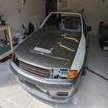Tightening The Crankshaft Bolt
Announcements
-
Similar Content
-
Latest Posts
-
Hmm... From my experience you get about 0.25° camber change per mm of RUCA length change. So, to correct from -2.5 up to less than -1° (or, more than -1° if you look at the world as a mathematician does) then you'd be making 6-8mm of length change on the RUCA. From a stock length of 308mm, that's 2-2.5% difference in RUCA length. My RUCAs are currently very close to stock length - certainly only 2-3mm different from stock. I had to adjust my tension arms by 6mm to minimise the bump steer. That's 6mm out of 210, which is 2.8%. That's a 2.8% change on those, compared to a <1% change on the RUCAs. So the stock geometry already has worse bump steer than is possible - you can improve it even if you don't change the RUCA length. If you lengthen the RUCAs at all, then you will definitely be adding bump steer. Again, with my car, I recently had an unpleasant amount of bump steer, stemming from a number of things that happened one after another without me having an opportunity to correct for them. I only had to change the tension arm lengths by 1mm to minimise the resulting bump steer. (Granted, I also had to dial out a lot of extra toe-in in the rear, and excessive rear toe-in will make bump steer behaviour worse). Relatively tiny little adjustments having been made - the car is now completely different. Was horrifying how much it wanted to steer from the rear on any significant single wheel bump/dip. And it was even bad on expansion joints on long sweepers on freeway entry/exits, which are notionally hitting both rear wheels at the same time. My point is, the crappy Nissan multilink is quite sensitive to these things (unlike the very nice Toyota suspension!). And I think 99.75% of Skyline owners are blissfully ignorant of what they are driving around on. Sadly, it is a non-trivial exercise to set up to measure and correct bump steer. I am happy to show my rig, which involves nasty chunks of wood bolted to the hub, mirrors, lasers, graph paper targets and other horrors. Just in case anyone wants to see how it is done. I'll just have to set it up to take the photos.
-
What do you have in that bad boy ? Ill go with the 725cc since I'll be going with Nistune ( would definitely like more engine protection but Haltech is too far out of reach at the moment... plus, Ill probably have a pretty safe tune as its a daily, not gonna be chasing peak power 24/7 ahahah ). Are Xspurt a safe choice? Pete's great. He didnt mention anything about traction arm length so I reckon it may be good. When I get some new wheels/tire later down the road I'll ask him about it and get his opinion on em. I heard from Gary that you've got the bilsteins too, are you running the sway bars too? and what other suspension goodies do you have installed or would recommend?





Recommended Posts
Create an account or sign in to comment
You need to be a member in order to leave a comment
Create an account
Sign up for a new account in our community. It's easy!
Register a new accountSign in
Already have an account? Sign in here.
Sign In Now